
Facebook’s New Ad Preferences: A Push for Ad Tracking Transparency
The how and why behind online ad targeting has long been a mystery to the public, but as of late, Facebook has made efforts to directly answer these questions, in a push for unparalleled ad transparency through their revamped ad preferences page. With their most recent advertising settings update, Facebook users can now dig into why they are seeing the ads they are seeing, how some advertisers got your information, and even make direct changes to which advertisers can reach them. While it may seem like this is bad for Facebook advertising, this move keeps their massive user base happy, which is Facebook’s biggest advertising strength. This isn’t a complete picture into Facebook’s ad serving strategy, but it’s one of the best looks the public has been given since the dawn of online advertising.
In This Article:
- How to Find the Facebook Ad Preferences Page
- Breakdown of What’s on the Ad Preferences Page?
- Why Would Facebook Want to Provide More Ad Preferences?
- How is More Ad Transparency Better for Advertisers?
How to Find the Facebook Ad Preferences Page
The ad preferences page has been around for a while, but Facebook has recently overhauled it, expanding the user’s control over and transparency of the ads they see. The new and improved page can be found at www.facebook.com/ads/preferences or by clicking the icon in the upper-right section of an ad, selecting “Why am I seeing this ad?” and then following the “Manage Your Ad Preferences” link in the pop-up.
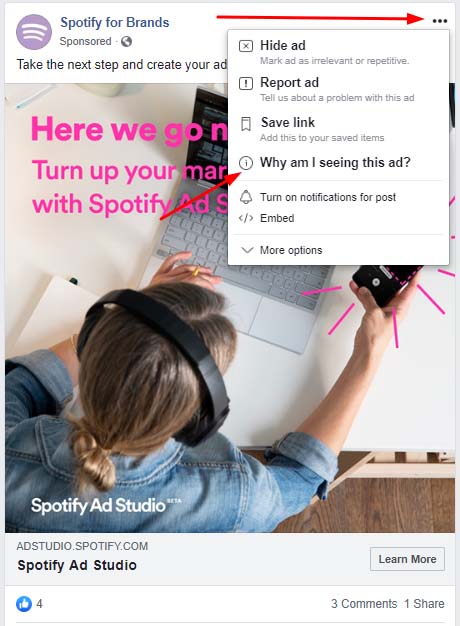
Breakdown of What’s on the Ad Preferences Page?
Within this page, Facebook users are given an in-depth breakdown of the profile advertisers use to target them by, what companies have been advertising to them recently, and their ability to control this profile. This page acts as a hub of information and data control, mixing new and pre-existing functionalities into a single location broken down into six sections.
- Your Interests
- Advertisers and Businesses
- Your Information
- Ad Settings
- Hide Ad Topics
- How Facebook Ads Work
Your Interests
The first section details what Facebook views as the user’s interests based on what company pages they like, interactions with ads on the platform, visits to Facebook’s partner sites, location data, and other factors. Broken down into subcategories, users can manually explore and edit what Facebook views of them. Due to the complicated nature of a person’s interests and ad interactions, this section can often be inaccurate without manual edits by the user. For example, here is my profile’s ad preferences page. Facebook has picked up on the fact that, yes, I sure do like food! But, I couldn’t tell you the last time I ate a salad. They’ve missed the mark a bit.
By editing their interests, a user can improve their ad experience by ensuring the ads they see are more relevant to their actual interests.
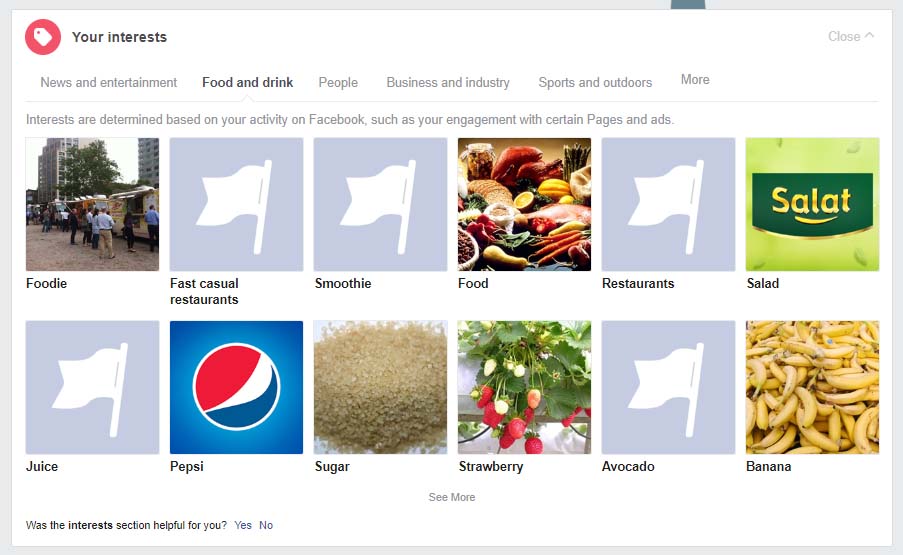
Advertisers and Businesses
While exploring the “Your interests” section can be entertaining, the meat of Facebook’s push for ad transparency is found in the second section, “Advertisers and Businesses.” This section shows Facebook users which brands have been using their information within the last 7 days, breaks down how that information was used, shows what brands their profile is connected with, and allows them to block brands from targeting them in the future. This is an incredibly powerful tool that could mean a permanent reduction to an advertiser’s audience pool if they are not careful with their ad campaigns.
Being one of the most complicated and relevant sections within ad preferences, everyone should take time to read through Facebook’s explanation on how these lists have been uploaded and shared. Facebook wants to be clear, they don’t sell users’ information, they only act as a vessel for others to share it.
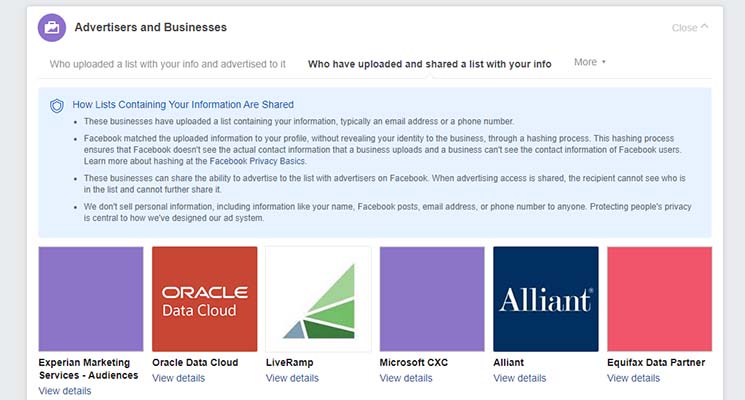
Each company listed includes a profile which can be found by clicking “View details.” These include a little insight into what it is and provides a link to their website or Facebook page.
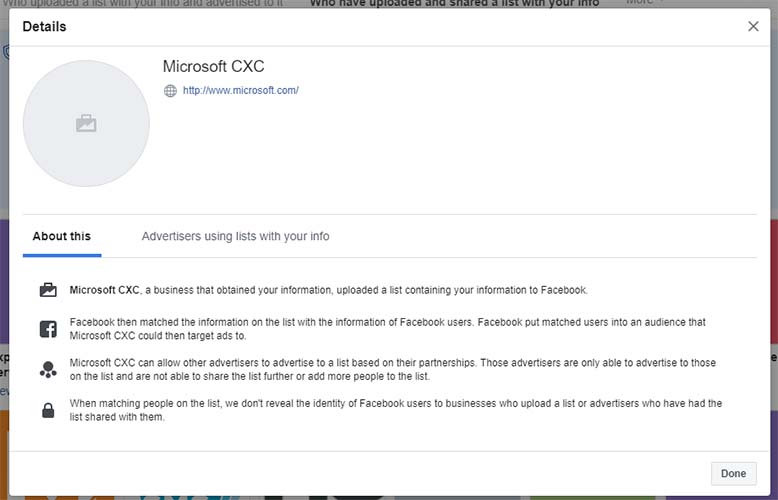
While interests are factored into the equation, the ads being served to a user can be traced more directly to the brands found in this section. Here’s a peek at all the companies that used my information in the last seven days. The shocking part is just how many have done that over just the last week and that I only know about half of them. Take look at these ad preferences for yourself. (And be sure to click “See More.”)
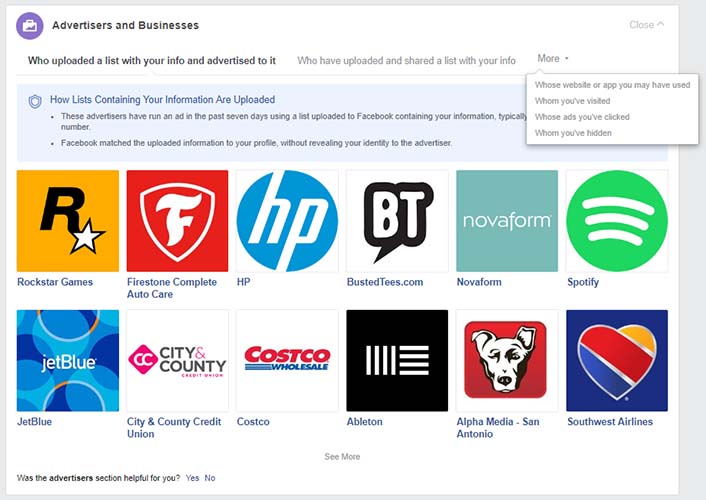
Your Information
A section familiar to most Facebook users, “Your information” basically holds the same information voluntarily uploaded to the user’s “About” section on their profile such as relationship status and employer. This section also details what usage categories Facebook has determined the user belongs to. These categories add to the user’s profile, allowing advertisements to be served relative to how the user interacts with the platform. These, too, can be manually removed from the user’s profile on this page.
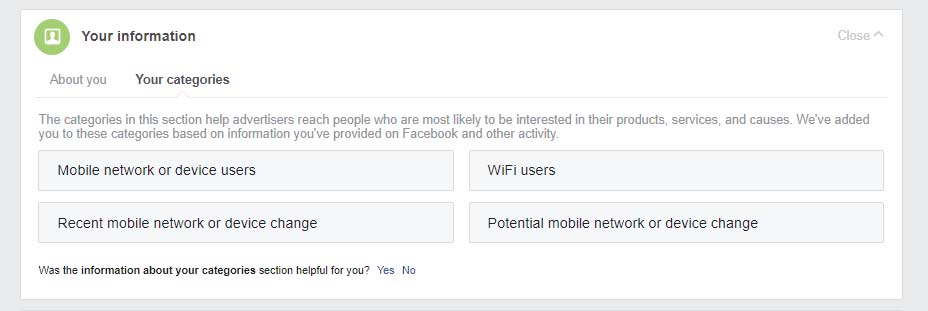
Ad Settings
While the “Advertisers and Businesses” section shows the users who is targeting them, “Ad settings” breaks down why. Divided into three expandable sub-categories, this section details how Facebook gathers its data on users and allows users to opt-out of certain tactics. Clicking each section provides more details about each setting, but here’s a quick rundown of each one:
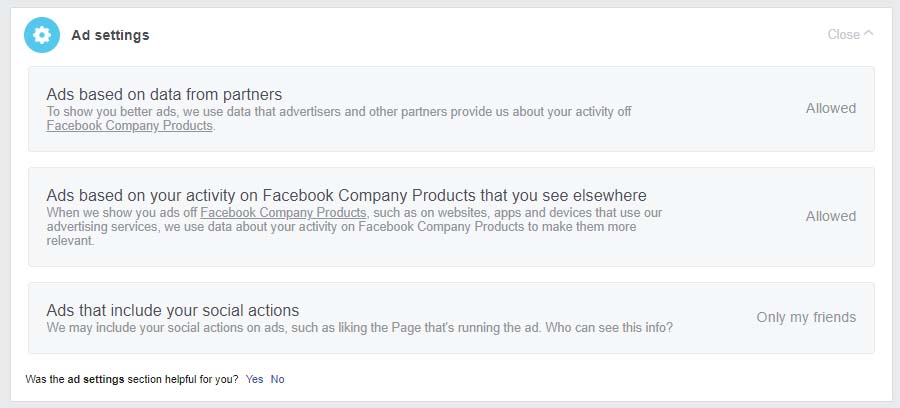
Ads based on data from partners
While Facebook doesn’t sell user information, they buy plenty of it. Facebook has a long list of partnered sites and apps who share their visitor’s information with Facebook. So when a user visits another website, Facebook takes note and serves related ads the next time they visit Facebook.
Ads based on your activity on Facebook Company Products that you see elsewhere
Facebook serves ads on the other websites and apps they own, like WhatsApp and Oculus, using the same system they use for Facebook. While opting out of this doesn’t prevent ads from being served on those platforms, it does stop the serving of highly targeted ads based on data gathered on Facebook. In other words, it prevents advertisers to follow a user cross-platform.
Ads that include your social actions
In an effort to make personal connections between ads and users, Facebook will show how the user’s friends have interacted with that brand. Ads from a brand that a user’s friend has liked will display a message on that ad that says “Jane Doe likes this” on the ad. So even if the friend didn’t like that specific ad, Facebook will make the connection and show the user that their friend likes that brand.
Hide Ad Topics
A more humanitarian section, “Hide ad topics” is included to allow people to block topics that are sensitive to them. Alcohol, Parenting, and Pets are the included categories, but Facebook has provided a suggestion box for users to suggest other sensitive topics that they would like to blanket block from their timeline. Even with the provided three topics, Facebook is clear that, “You may still see ads related to this topic,” and even fewer guarantees for the suggested topics. The assumption is Facebook chose these three topics based on report data and will use the suggested topics data for future expansion into more sensitive categories to choose from
What this section means on the advertiser side of the equation: new user categories. When users opt-out of alcohol ads, they are added to a pool of non-alcohol friendly users, building out Facebook’s understanding of what ads will work well with them and giving advertisers more accurate audience targeting. Budweiser doesn’t want to spend money sending ads to someone who doesn’t drink. Facebook can use the people opting out of this category to create a new audience of non-drinkers/alcohol-sensitive folks for advertisers like Budweiser to exclude in their campaigns.
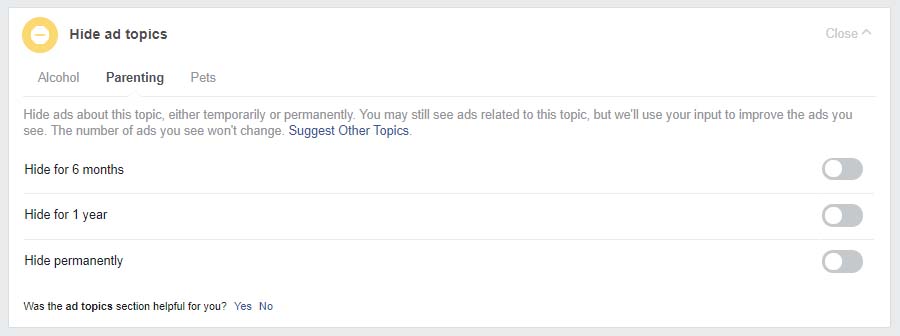
How Facebook Ads Work
The final section is simply a link to a page that explains the basics of Facebook’s ad targeting, what factors are considered when targeting an ad, and other advertising FAQs. Where “Your ad preferences” is a page mostly about explaining a user’s specific ad experience, “About Facebook Ads” is a general lesson over the topic, written for the user rather than the advertiser.
Why Would Facebook Want to Provide More Ad Preferences?
As with any free service online, Facebook uses its user base as a commodity to sell to advertisers. So why would Facebook take any power away from their advertisers, even to the point of letting users avoid certain companies entirely?
Saving Face
It’s no secret that Facebook has had some PR “challenges” over the years. Between privacy breaches, data leaks, and Zuckerberg’s (painful!) congressional inquisition, they have been on the news for all the wrong reasons. The public’s opinion surrounding advertising and privacy on the platform has long been rocky, with theories like Facebook listening to user conversations through their phones even though they say they don’t, and people like Steve Wozniak recommending everyone gets off Facebook getting headlines. Any company would see these as issues needing to be addressed.
Saving Audience
So these efforts to be more transparent and give the users more control over their ad experience are likely an attempt to improve their public image, especially in relation to other social media platforms. While these moves take away some control from advertisers, the biggest threat to Facebook is a mass migration of users off of the platform and to one of their competitors. Facebook has ingrained itself into the average person’s life, but if the public doesn’t feel comfortable using the platform, that could be enough to pull people, and advertisers, away.
How is More Ad Transparency Better for Advertisers?
Yes, control is being taken away from advertisers, but in the long run, this looks to be a net positive. Ideally, users will work through their profiles and clean up their assigned interests, allowing advertisers to more accurately target them with relevant ads. Realistically, however, the majority of users that are going to interact with this page are concerned about their privacy and will opt out of everything, eliminating them from being reached by relevant ads. The largest benefit for advertisers comes from the users’ faith in the platform. By being one of the only online platforms pushing ad transparency and giving users in-depth control of their ad preferences, Facebook is making people more comfortable using their platform. This will allow advertisers to continue to reach them for years to come.





